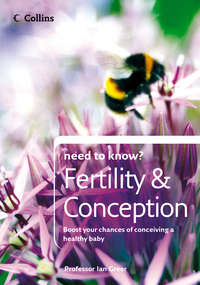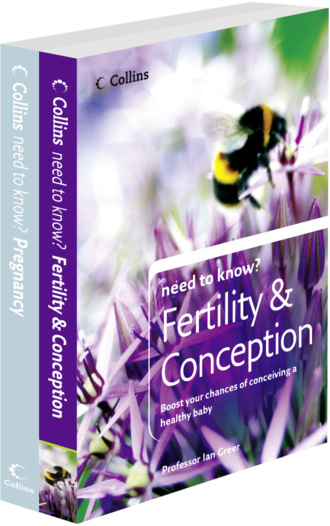
Полная версия
Need to Know Fertility, Conception and Pregnancy

need to know?
Fertility & Conception and Pregnancy
Harriet Sharkey and Prof. Ian Greer

Table of Contents
Cover Page
Title Page
Need to Know Fertility and Conception
Need to Know Pregnancy
Copyright
About the Publisher
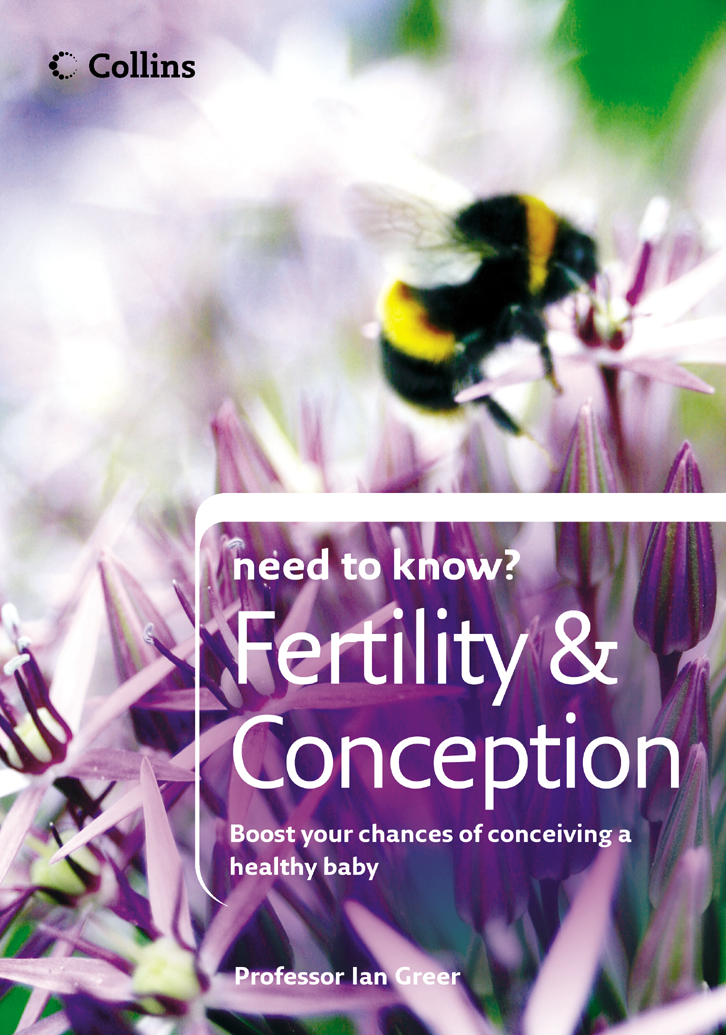
Table of Contents
Cover Page
1. Conception
2. A healthy pregnancy
3. Fertility problems and treatment
4. Assisted conception
5. You’re pregnant!
6. Facing problems
List of Search Terms
1. Conception
It takes just one egg and one sperm to conceive, but getting them together is not always easy. Following sex, over 250 million sperm set off on a ‘race’ to find and fertilize the egg, but only one makes it all the way to the finish to enter the egg and trigger the whole process of making your baby. These are tough odds. But this is not the beginning, because producing the sperm and eggs is the culmination of complex processes in your and your partner’s bodies, processes that must be carefully regulated by reproductive hormones (chemical messengers). So when starting to think about pregnancy perhaps the most logical starting point is to understand how your own body’s reproductive system works.
The menstrual cycle
Regular menstrual bleeding is controlled by a complex system. The brain controls the release of ‘signalling’ hormones called gonadotrophins from the pituitary gland at the base of the brain. There are two gonadotrophins: follicle-stimulating hormone (FSH) and luteinising hormone (LH).
Ovulation
must know
Blood loss
Periods usually last for five to seven days. No matter whether periods are light or heavy, most of the blood is lost in the first three days. Average monthly blood loss is 30-40 ml (2-2¼ fl oz). Women with abnormally heavy periods lose over 80 ml (nearly 3 fl oz) of blood each time.
A woman is born with a lifetime’s supply of eggs. During each menstrual cycle, FSH stimulates immature eggs contained in the ovaries to develop within small fluid-filled sacs known as follicles. Initially, several eggs begin to mature but generally only one continues to develop to full maturity. This is known as the ‘dominant follicle’. Other eggs stop developing and disintegrate. When the egg is mature, the follicle it is contained within is about 2 cm (¾in) in diameter. As well as nurturing a developing egg, follicles also produce the female hormone oestrogen. When oestrogen levels are optimal and the egg is fully developed, the release of luteinising hormone (LH) occurs. This surge in the LH level triggers the release of the egg. This process is called ovulation.
Ovulation deals with egg production. However, if this egg is fertilized, it needs to implant in the womb. So it is important for the womb to be prepared for a fertilized egg, and oestrogen has a role here too. Oestrogen stimulates the lining of the womb (the endometrium) to grow and thicken. After the egg is released from the ovary, the remains of the follicle that released the egg produces a
did you know?
Your cycle length
• This whole process takes around a month, and so the interval between menstrual periods is most commonly about 28 days.
• In some women, the cycle can occur every 21 days while in others it may take up to 35 days. So the normal range for the menstrual cycle is between 21 and 35 days.
• Day 1 of a cycle is the first day on which menstrual bleeding will occur.
hormone called progesterone. (Progesterone is only made after an egg is released.) It acts on the lining of the womb by stopping its thickening at the right stage. It also improves the endometrium’s blood supply and makes it a suitable and ‘comfortable’ environment for the fertilized egg to implant.
If a fertilized egg does not implant, the production of progesterone from the ovary falls sharply. As these hormone levels fall, the blood supply to the lining of the womb is reduced and the endometrium is shed. This results in the bleeding that we know as a period. The cycle then starts over again.
Time of ovulation
As ovulation (production of a mature egg) is essential for a regular menstrual cycle, women who have a regular cycle in the normal range are usually ovulating regularly. Conversely, women who do not ovulate regularly have irregular and usually infrequent periods.
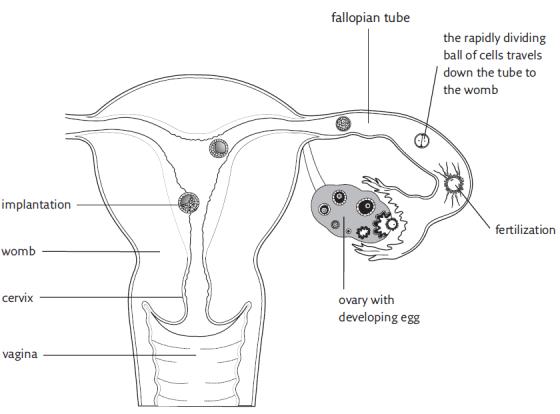
The time of ovulation depends on the length of the menstrual cycle. If a woman has a 28-day cycle, ovulation occurs at around day 14, and if she has a 21-day cycle, ovulation occurs at around day 7. The time taken to mature an egg and ovulate can vary from woman to woman. The part of the cycle during which the egg develops is called the follicular phase, as the egg develops in a small ‘follicle’ or cyst in the ovary. However, the time from ovulation to a period (if fertilization does not occur) is fixed at around 14 days. This is called the secretary phase of the cycle as the ovary makes and ‘secretes’ progesterone. Provided your cycle is regular, you will be able to estimate when you will be ovulating.
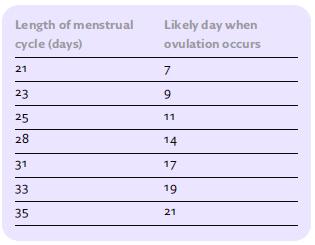
The optimum time of fertility
A woman is at her most fertile in the days around ovulation, and for a 28-day cycle this would be from days 12 to 15.
• To work out your fertile time, you need to estimate when ovulation will occur, which is usually 14 days before the first day on which your next period is due.
• For example, let’s say that your period is due to start on 24 August. Take 14 days from 24 August and this is the date around which you will ovulate. In this example, it is 10 August.
• Once an egg is released, it remains viable for around a day. Allow a day or so on either side of this for minor variations in the time of ovulation. Sperm can remain viable in the woman’s body for around two days.
• Therefore, the fertile time is estimated as being from two to three days before to two days after the estimated time of ovulation. This is the best time to try to conceive.
Some women know when they are ovulating because they feel lower abdominal pain at the time when the egg is released from the ovary. The pain is quite normal and is referred to as ‘Mittelschmerz’ (from German words for ‘middle’ and ‘pain’ – hence pain felt mid-cycle).
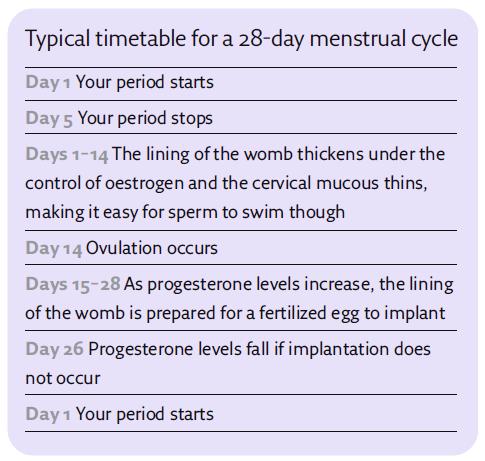
It’s time to conceive
Many women wonder if they need to see their doctor for a health assessment before they conceive. However, no specific check-up is usually necessary if you are healthy, have no history of miscarriage, pregnancy complications or of a long-standing medical condition.
Stopping using contraception
If you have been using a form of contraception to prevent pregnancy, depending on what method this is, the length of time it might then take you to become pregnant is affected. Barrier methods do not disturb ovulation or the menstrual cycle and you can simply stop at any time. There is no need to delay attempts to conceive provided there are no other menstrual or medical problems.
must know
Smear test
Check that your cervical smear tests are up to date before conceiving. If you need treatment for an abnormal smear, this should, ideally, be carried out before you get pregnant.
If you use an intrauterine contraceptive device, or ‘coil’, for contraception then this must be removed before you try to conceive. It is probably best to delay conception until at least the next cycle as the coil may have disturbed the lining of the womb. So, after the doctor has removed the coil, you should use another technique, such as barrier contraception, until you are ready to conceive.
If you use the oral contraceptive pill or an injectable contraceptive, your normal menstrual cycle and ovulation is disrupted. The time from stopping the pill to ovulating is extremely variable. Estimates of the time of ovulation are based on the date when the next natural (not pill-induced) period is expected, so it is impossible to estimate when ovulation will occur after stopping the pill.
If you wish to get pregnant, it is best to stop taking the pill or injectable contraceptive and wait until your normal menstrual cycle resumes before trying to conceive. As this may take about three normal menstrual periods, you might want to use a technique such as barrier contraception until your cycle has stabilized. If you become pregnant before the regular rhythm of your periods has become established, this can make it difficult to predict your delivery date based on your last period. However, a reliable estimate of the stage of the pregnancy can be obtained with an ultrasound scan to measure the size of the developing baby.
did you know?
Temperature change
• The typical change seen before ovulation would be a body temperature of 36.6-36.8 °C (97.9-98.2 °F), which falls to 36.2-36.4 °C (97.2-97.5 °F).
• The temperature would then increase to, say, 37-37.1 °C (98.6-98.8 °F) by around 36 hours after ovulation.
• If you regularly chart your temperature, you will see a pattern developing.
Using your body temperature to predict ovulation
Your body temperature should fall slightly before ovulation then rise quickly afterwards. It is worth noting, however, that sometimes the fall prior to ovulation is absent. The increase in temperature occurs in response to the progesterone that is produced after ovulation occurs. Progesterone levels and the body temperature remain elevated until a day or so before the next period begins. If pregnancy occurs, the temperature rise (and elevated progesterone levels) persists.
• If you want to use this technique to find out when you are ovulating, take your temperature with a thermometer in the morning before getting out of bed. Any medical thermometer that can measure in tenths of 1 °C can be used. Thermometers (including electronic ones) and temperature charts can be purchased from pharmacies.
• If you are recording an oral temperature reading, remember to check your temperature before drinking anything hot or cold to avoid getting an inaccurate reading.
• Take your temperature at the same time every day.
• Repeat for each cycle that you want to check for ovulation. If you have a regular cycle, ovulation is likely to occur at around the same time during each cycle.
The downside of using this method to check for your fertile period is that your temperature rise occurs after ovulation and by the time your temperature has risen, the egg may no longer be viable. If you have a regular menstrual cycle, however, the time of ovulation may be anticipated based on a well-recorded pattern in temperature rise. This then allows intercourse to be timed to coincide with ovulation.
Consistency of vaginal mucous
The consistency of vaginal mucous can help predict the fertile phase as the character of the discharge varies through the menstrual cycle. Just after a period, it is scant, sticky and thick. Just before the time of ovulation, when oestrogen levels are high, the amount of mucous increases and it becomes watery, stringy and clear – a bit like raw egg white.
If you collect the mucous on your finger at this time and try to stretch it between your thumb and forefinger, it elongates for several inches without breaking. After the fertile phase, the mucous again becomes thicker. Sperm can survive particularly well in the thinner ‘fertile’ mucous, which also makes it easier for the sperm to get through the cervix and into the womb. So charting the pattern of changes in your vaginal mucous can also help you work out when you are ovulating.
Ovulation prediction kit
If you want to know when you are likely to be most fertile, you could buy an ovulation prediction kit. These kits, which are available from pharmacies, measure the amount of luteinising hormone (LH) – the hormone that stimulates the release of eggs from your ovaries each month – in your urine.
The kit identifies a surge in this hormone, which precedes ovulation by around twelve hours. This can help establish the fertile days in your cycle. Ovulation prediction kits are more accurate than temperature charts and avoid the need for regular temperature assessment, but they are also more expensive.
Frequency of intercourse
However, even with temperature charts or ovulation prediction kits, it is often difficult to identify the precise time of ovulation in advance. So, from a practical perspective, you should have intercourse several times around the estimated time of ovulation. Doctors have found that having intercourse once a week makes you 50 per cent less likely to conceive than having it every couple of days. Success rates do not appear to get significantly higher if you have sex every day. Sperm survives in the woman and is capable of fertilizing an egg for around two days after intercourse, especially during her most fertile time. In addition, there is no need to restrict intercourse at other times of the month. Indeed, the best plan is to have intercourse regularly every couple of days throughout the cycle. This avoids putting pressure on you both to identify the fertile time, obliging you to make love according to the calendar rather than by desire.
Sperm production
It is the same gonadotrophins that occur in women (follicle-stimulating hormone (FSH) and luteinising hormone (LH)) that regulate sperm production in men. These hormones, or signalling molecules, are released from the man’s pituitary gland at the base of the brain.
The sperm’s journey
Follicle-stimulating hormone (FSH) stimulates the testicles to produce sperm – over 12 billion are produced each month. Luteinising hormone (LH) stimulates production of the male hormone testosterone within the testicles. Testosterone is essential for normal sperm production. After sperm are produced, they then have a long journey ahead before they are ready to fertilize an egg.
When they leave the testicles, they travel down a very fine coiled tube attached to the testicle called the epididymis, which is about 5-6 m (16-20 ft) long. Sperm entering the epididymis lack the ability to swim forwards, which is necessary to reach the egg. But as the epididymis sweeps them along, the sperm mature, so that by the time they reach the end of the epididymis, they have the ability to move or swim forwards. This whole process takes over 70 days.
Sperm are stored at the end of the epididymis. From there they flow into another tube, which connects the epididymis to the penis. This is called the vas deferens. This tube is about 30 cm (12 in)
did you know?
Cool sperm
Sperm develop better at a temperature slightly cooler than the main body temperature, which is one reason why the testicles lie outside the body in the scrotum.
long and is coated in muscle. The sperm are propelled along the vas deferens by muscular contractions, and along the way they are mixed with seminal fluid produced from glands prior to ejaculation. This fluid is rich in nutrients to help keep the sperm alive and healthy after they are deposited in the vagina. This mixture of sperm and seminal fluid is called semen. About 2-4 ml (½-1 tsp) of semen containing many millions of sperm is released when ejaculation occurs. However, the sperm don’t become completely mature until after ejaculation. It is only after ejaculation that they develop the capacity to break through the outer coating of the egg and fertilize it.

Conception
Normally a minimum of 40 million sperm are released with each ejaculation, but typically the quantity is over 80 million and often well in excess of 250 million. Although some are lost from the vagina, many make their way through the cervix (helped by the thin, watery mucous produced if the woman is fertile) into the womb and up into the fallopian tubes.
Egg meets sperm
The egg, having been released from the ovary, is picked up by the finger-like ends of a fallopian tube and transported down the tube. Fertilization of the egg occurs about one-third of the way down the fallopian tube. The egg is surrounded by sperm and eventually one sperm succeeds in penetrating the outer layer of the egg. This is the point of conception, after which no other sperm can penetrate the egg.
After conception, the genetic material (chromosomes) of the sperm and egg cells merge with each other and then the fertilized egg, which starts off as a single cell, divides to form two cells, then four, and then eight, and so on until a ball of cells is formed. This ball of cells continues its journey down the fallopian tube to the womb, where it stays for around three days, bathed in secretions from the womb.
About seven days after ovulation, it implants into the wall of the womb, whose lining has been prepared by the production of progesterone from the ovary. Another hormone, human chorionic gonadotrophin (hCG), is produced by the developing placenta. This maintains the production of progesterone from the ovary to help to support the early pregnancy. The ball of cells, once implanted, organizes itself into two different layers of cells, one that becomes the embryo and the other, the placenta.
Genetic make-up and conception
All cells in the body contain DNA (deoxyribonucleic acid), the substance that makes up your genetic code. For this reason, DNA is sometimes referred to as the ‘building blocks’ of life. This is what makes you what you are, the blueprint for the structure and function of your body. Everyone except identical twins has a different genetic code. Your genetic code is made up of thousands of genes that are carried on ‘chromosomes’. Each of us has 23 pairs of chromosomes in every cell in our body – a total of 46 chromosomes per cell. Of the 23 pairs of chromosomes in every cell, 22 pairs are ‘general’ chromosomes and one is a pair of ‘sex’ chromosomes.
Sperm and eggs are an exception to this general rule. An egg from a female has only 23 chromosomes; 22 of these are ‘general’ chromosomes and one is a ‘sex’ chromosome. The sperm from the male also has only 23 chromosomes: 22 general chromosomes and one sex chromosome. When conception occurs and the sperm fertilizes the egg, the egg and sperm cells fuse. A fertilized egg therefore has the full complement of 46 chromosomes and the baby that grows from the egg has 46 chromosomes in every cell.
The sex of the baby conceived is determined by the ‘sex’ chromosomes – referred to as ‘X’ and ‘Y’ chromosomes – and the way these combine determines whether we are male or female. All girls have two X chromosomes and no Y chromosome, while a boy has one X and one Y chromosome. It is the sex chromosome that comes from the father’s sperm that determines the sex of your baby. The mother has no power to influence the sex of the baby because she can contribute only an X chromosome, whereas the father can contribute either an X or a Y chromosome.
Sexual position and conception
Provided intercourse is comfortable and semen is deposited at the top of the vagina, the sexual position should not influence conception. However, it is perhaps best for the woman to avoid more upright positions after the man ejaculates to prevent some of the semen draining out of the vagina, although there is no evidence that resting after intercourse increases the likelihood of pregnancy. Equally, there is no truth in the old wives’ tale that you can’t get pregnant if you have intercourse standing up.
Age and conception
There is no ‘ideal’ time to get pregnant. Fertility varies from person to person, although fertility in both men and women reaches its peak at about the age of 24 years. Many women are now delaying pregnancy until their 30s and even 40s where, once over the age of 35, they are at greater risk of developing complications such as high blood pressure during pregnancy. If you are over 35 years old, there is also a higher risk of chromosomal problems in the fetus, such as Down’s syndrome.
It is not just older mothers who are at increased risk of problems. The risk of complications is also higher if you have a pregnancy when you are a teenager. So, from the doctor’s perspective, having your babies somewhere between the age of 20 and 35 is best in order to minimize the risk of complications, some of which can be serious. However, you may not be at a stage in your life when you can have your babies at that time. So do remember that the majority of women over 35 have a successful pregnancy outcome. It is important to keep these extra risks associated with age in perspective, but seek medical advice if you have any particular concerns and, in particular, if you have an existing medical problem. The ‘best’ time to become pregnant depends largely on what is best for you and your partner, taking into account and weighing up everything that is going on in both your lives and thinking about what pregnancy will mean for you.
Конец ознакомительного фрагмента.
Текст предоставлен ООО «ЛитРес».
Прочитайте эту книгу целиком, купив полную легальную версию на ЛитРес.
Безопасно оплатить книгу можно банковской картой Visa, MasterCard, Maestro, со счета мобильного телефона, с платежного терминала, в салоне МТС или Связной, через PayPal, WebMoney, Яндекс.Деньги, QIWI Кошелек, бонусными картами или другим удобным Вам способом.





